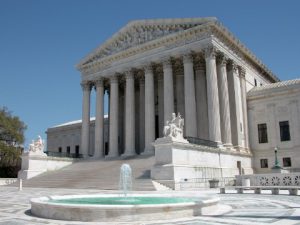 Of the 12 petitions in which the Supreme Court granted certiorari last Friday, the Moody v. Netchoice and Netchoice v. Paxton grants garnered the most public attention. But law nerds like us, especially those focused on the Administrative State, were equally intrigued by the justices adding Corner Post, Inc. v. Bd. of Governors, FRS to the Court’s 2023 docket. Corner Post involves the Administrative Procedure Act’s (APA) six-year statute of limitations, found in Section 2401(a). The Court will decide the specific issue of when a plaintiff’s “right of action first accrues”—does the six-year period begin when a federal agency issues a rule, or when the rule causes a plaintiff some redressable harm?
Of the 12 petitions in which the Supreme Court granted certiorari last Friday, the Moody v. Netchoice and Netchoice v. Paxton grants garnered the most public attention. But law nerds like us, especially those focused on the Administrative State, were equally intrigued by the justices adding Corner Post, Inc. v. Bd. of Governors, FRS to the Court’s 2023 docket. Corner Post involves the Administrative Procedure Act’s (APA) six-year statute of limitations, found in Section 2401(a). The Court will decide the specific issue of when a plaintiff’s “right of action first accrues”—does the six-year period begin when a federal agency issues a rule, or when the rule causes a plaintiff some redressable harm?
We looked at the docket and found that two frequent amici (Cato Institute and NFIB Small Business Legal Center) supported Corner Post’s petition. We were surprised to also discover a brief filed by attorney John Kendrick. We’re proud to note that during the summer before his senior year at William & Mary, John performed a summer internship with WLF. John was a prolific writer in his three months at WLF, authoring blog posts on food-labeling class actions, a private-plaintiff empowering patent law, and whether the Supreme Court was “pro-business,” as well as a WLF Legal Opinion Letter on questionable copyright litigation.
As a student at the University of Virginia School of Law, John authored a student Note for the law review entitled “(Un)limiting Administrative Review: Wind River, Section 2401(a), and the Right to Challenge Federal Agencies.” The “Interests of Amicus Curiae” page in John’s Corner Post brief notes that his Virginia Law Review Note is “the only scholarly article on Section 2401(a).” In the article, John argues that a right of action “accrues” under the APA when a plaintiff suffers an injury. Courts concluding that an action accrues not at the time of a plaintiff’s injury, but when an agency issues the allegedly offending rule—which include the Eighth Circuit in Corner Post and five other circuits—perversely allows that limitation period to begin before a plaintiff suffers an injury or even before the plaintiff came into existence. The Sixth Circuit, in an opinion by Chief Judge Jeffrey Sutton, held that APA actions accrue when a plaintiff suffers harm.
We expect that as the briefing in this case proceeds, public attention, especially from those invested in the continued expansion of the Administrative State, will grow. As John Kendrick explained in the introduction to his Note:
Indeed, the implications of this Note’s conclusion are dramatic. If it is right, then there is no general time limit on APA claims. Every decision made by every federal agency during its entire history can be freshly challenged on policy or procedure, so long as the decision has injured the plaintiff within the past six years.
Our congratulations to John, and we look forward to reading his merits amicus brief.
